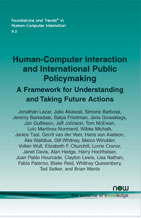Human–Computer Interaction and International Public Policymaking: A Framework for Understanding and Taking Future Actions
By Jonathan Lazar, Towson University and Harvard University, USA, jlazar@towson.edu | Julio Abascal, University of the Basque Country, Spain | Simone Barbosa, PUC-Rio, Brazil | Jeremy Barksdale, Virginia Tech, USA | Batya Friedman, University of Washington, United States | Jens Grossklags, Pennsylvania State University, USA | Jan Gulliksen, KTH, Sweden | Jeff Johnson, UI Wizards, Inc. and Wiser Usability, Inc., USA | Tom McEwan, Edinburgh Napier University, UK | Loïc Martínez-Normand, Universidad Politécnica de Madrid, Spain | Wibke Michalk, Karlsruhe Institute of Technology, Germany | Janice Tsai, Microsoft Research, USA | Gerrit van der Veer, Open University, The Netherlands | Hans von Axelson, Handisam, Sweden | Ake Walldius, KTH, Sweden | Gill Whitney, Middlesex University, UK | Marco Winckler, Université Paul Sabatier, France | Volker Wulf, University of Siegen, Germany | Elizabeth F. Churchill, Google, USA | Lorrie Cranor, Carnegie Mellon University, USA | Janet Davis, Grinnell College, USA | Alan Hedge, Cornell University, USA | Harry Hochheiser, University of Pittsburgh, USA | Juan Pablo Hourcade, University of Iowa, USA | Clayton Lewis, University of Colorado, USA | Lisa Nathan, University of British Columbia, Canada | Fabio Paterno, CNR-ISTI, Italy | Blake Reid, University of Colorado, USA | Whitney Quesenbery, Center for Civic Design, USA | Ted Selker, CITRIS, UC Berkeley, USA | Brian Wentz, Shippensburg University, USA
Abstract
This monograph lays out a discussion framework for understanding the role of human–computer interaction (HCI) in public policymaking. We take an international view, discussing potential areas for research and application, and their potential for impact. Little has been written about the intersection of HCI and public policy; existing reports typically focus on one specific policy issue or incident. To date, there has been no overarching view of the areas of existing impact and potential impact. We have begun that analysis and argue here that such a global view is needed. Our aims are to provide a solid foundation for discussion, cooperation and collaborative interaction, and to outline future programs of activity. The five sections of this report provide relevant background along with a preliminary version of what we expect to be an evolving framework. Sections 1 and 2 provides an introduction to HCI and public policy. Section 3 discusses how HCI already informs public policy, with representative examples. Section 4 discusses how public policy influences HCI and provides representative public policy areas relevant to HCI, where HCI could have even more impact in the future: (i) laws, regulations, and guidelines for HCI research, (ii) HCI research assessments, (iii) research funding, (iv) laws for interface design — accessibility and language, (v) data privacy laws and regulations, (vi) intellectual property, and (vii) laws and regulations in specific sectors. There is a striking difference between where the HCI community has had impact (Section 3) and the many areas of potential involvement (Section 4). Section 5 a framework for action by the HCI community in public policy internationally. This monograph summarizes the observations and recommendations from a daylong workshop at the CHI 2013 conference in Paris, France. The workshop invited the community's perspectives regarding the intersection of governmental policies, international and domestic standards, recent HCI research discoveries, and emergent considerations and challenges. It also incorporates contributions made after the workshop by workshop participants and by individuals who were unable to participate in the workshop but whose work and interests were highly related and relevant.
Human–Computer Interaction and International Public Policymaking: A Framework for Understanding and Taking Future Actions
This monograph lays out a discussion framework for understanding the role of humancomputer interaction (HCI) in public policymaking. It takes an international view, discussing potential areas for research and application and their potential for impact. The aim is to provide a solid foundation for discussion, cooperation and collaborative interaction, and to outline future programs of activity. It starts with an introduction to HCI and public policy and goes on to discuss how HCI research and practices already inform public policy, providing representative examples. It then discusses how public policy influences HCI and provides representative public policy areas that are relevant to HCI, and where HCI could have even more impact in the future. It concludes by laying out a framework for involvement and suggested actions by the HCI community in public policy internationally. This monograph summarizes the observations and recommendations from a daylong workshop at the CHI 2013 conference in Paris, France. The workshop invited the community's perspectives regarding the intersection of governmental policies, international and domestic standards, recent HCI research discoveries, and emergent considerations and challenges. It also incorporates contributions made after the workshop by workshop participants and by individuals who were unable to participate in the workshop but whose work and interests were highly related and relevant.
